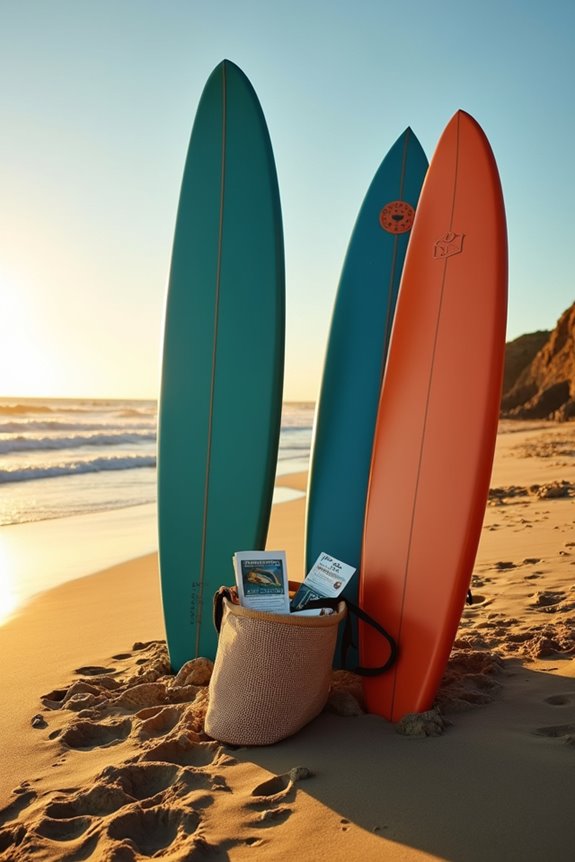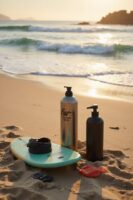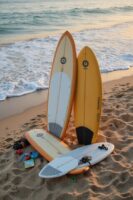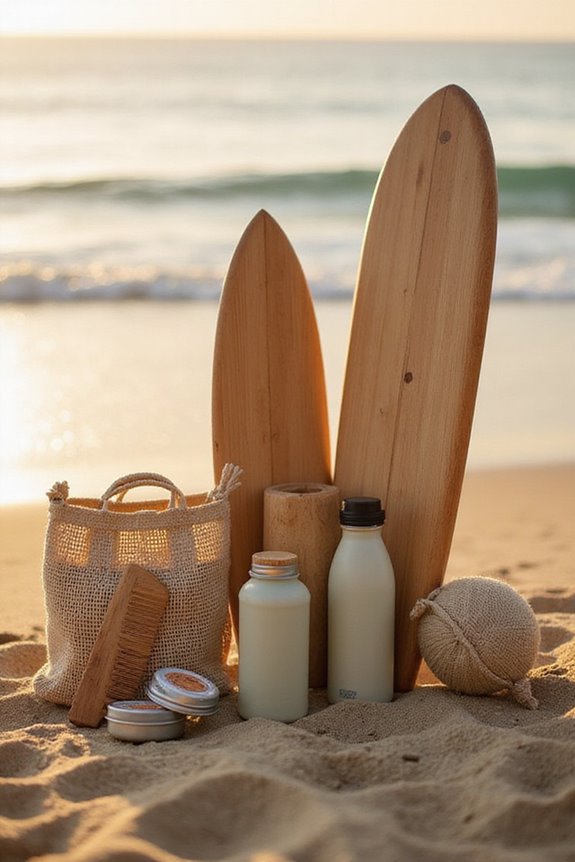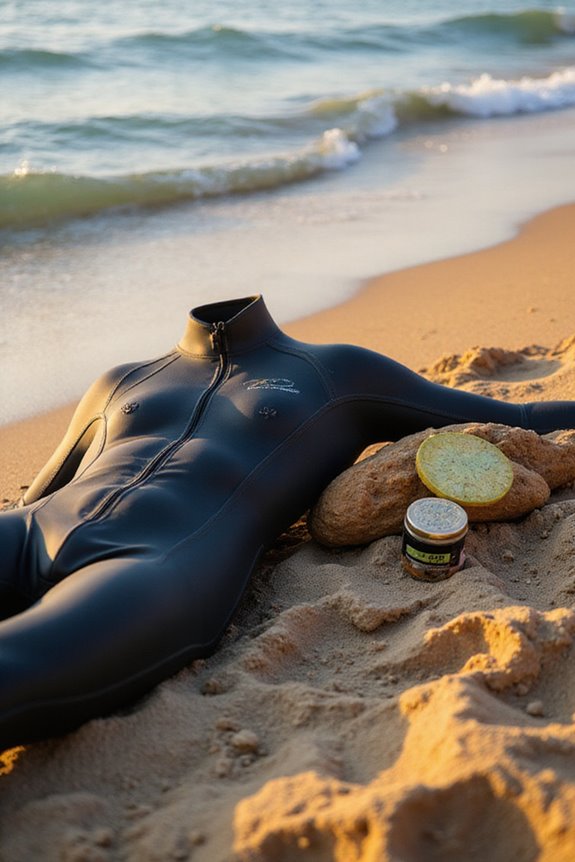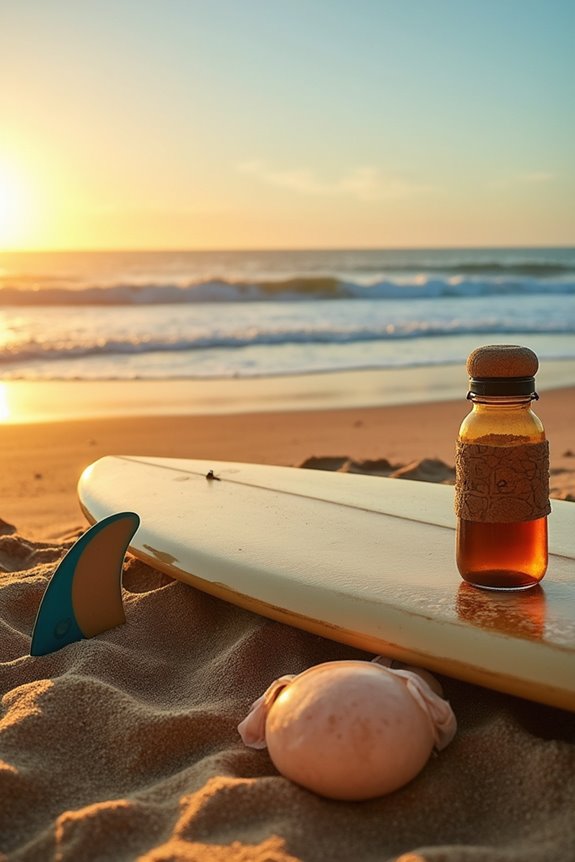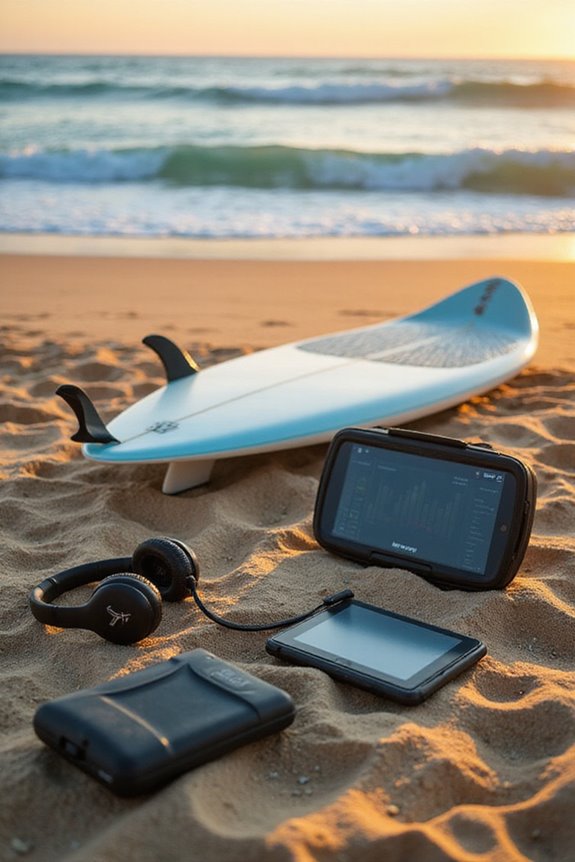To respect local wildlife while surfing, we should understand marine species, such as dolphins and seals. Following surf etiquette is key; the closest surfer to the wave has the right of way. We must be aware of protected surf areas that conserve habitats and avoid surfing after heavy rainfall due to pollution risks. Engaging in local conservation efforts, like beach cleanups and supporting sustainable practices, can help protect our coastlines. Let’s explore how we can make a bigger impact together.
Key Takeaways
- Observe marine wildlife from a distance to avoid disturbing their natural behavior and habitats.
- Follow surf etiquette to minimize conflicts with other surfers and protect local wildlife.
- Avoid surfing in protected areas and respect seasonal restrictions to preserve marine ecosystems.
- Use biodegradable and reef-safe sunscreens to reduce chemical pollution in the ocean.
- Participate in local conservation efforts, such as beach cleanups, to help maintain healthy surf environments.
Understanding Local Marine Wildlife
When we think about surfing, we often imagine the thrill of riding waves, but it’s essential to recognize the diverse marine wildlife inhabiting these coastal areas. Many marine species, such as surfperch, croakers, dolphins, and seals, play important roles in the ecosystem.
- Dolphins are social, often seen riding waves and traveling in pods for safety.
- Seals can be quiet near the shore, while sea lions are more vocal and active.
- Seabirds, like gulls and pelicans, dive for fish and indicate ecosystem health.
Understanding wildlife behavior helps us respect these animals. By maintaining a safe distance and avoiding disturbances, we can enjoy our surfing experience while protecting these essential marine species and their habitats. Additionally, being aware of local surf reports ensures that we are informed about any wildlife activity in the area, promoting a safer surfing environment for both surfers and marine life.
Importance of Surf Etiquette
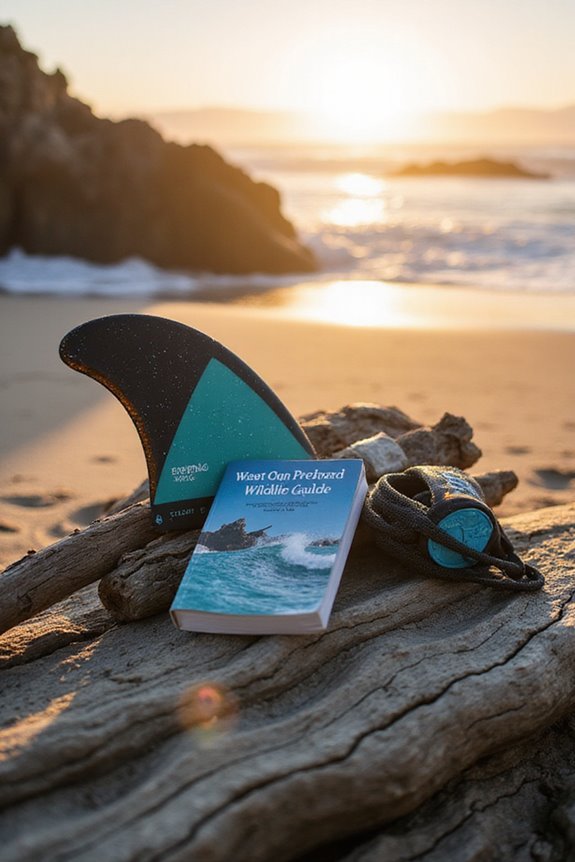
Surf etiquette plays a significant role in ensuring a safe and enjoyable experience for everyone in the water. By understanding wave priority, we can minimize conflicts and enhance our surfing sessions. The surfer closest to the wave peak has priority, so it’s essential to wait our turn and avoid “snaking” another surfer.
To maintain safety and fairness, only one surfer should ride a wave at a time. Positioning ourselves correctly in the lineup helps us integrate smoothly into the wave rotation. Clear communication about our intentions to catch a wave fosters mutual respect among surfers. By practicing these principles, we contribute to a more harmonious surfing environment that respects both our fellow surfers and the local wildlife. Additionally, understanding ocean dynamics is crucial for making informed decisions while surfing, which can help reduce disturbances to marine life.
Recognizing Protected Surf Areas
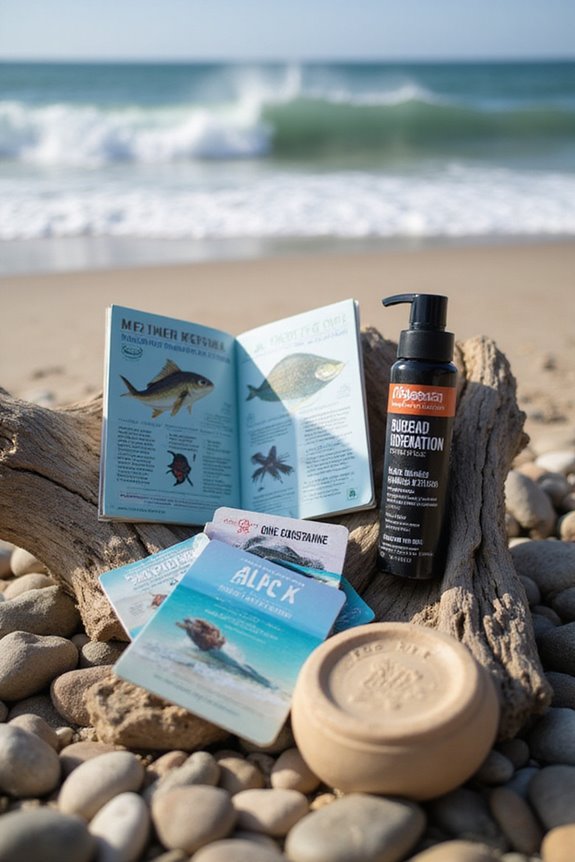
Understanding protected surf areas is essential for surfers who want to enjoy their sport while respecting local wildlife and ecosystems. These protected surf zones are often designated by wildlife conservation regulations to safeguard sensitive habitats. For instance, some areas, like the Back Bay National Wildlife Refuge, prohibit surfing entirely to preserve local wildlife.
In these zones, specific activities may be restricted, including the use of vehicles and drones, to minimize human impact. Access to certain beaches or trails may also be limited seasonally or permanently. By being aware of these protections, we can guarantee that our surfing practices align with conservation goals, helping to maintain the ecological balance and enhance our overall experience in the water. Additionally, recognizing seasonal weather patterns can help surfers choose the best times to minimize their impact on local wildlife.
Minimizing Pollution in Surf Zones
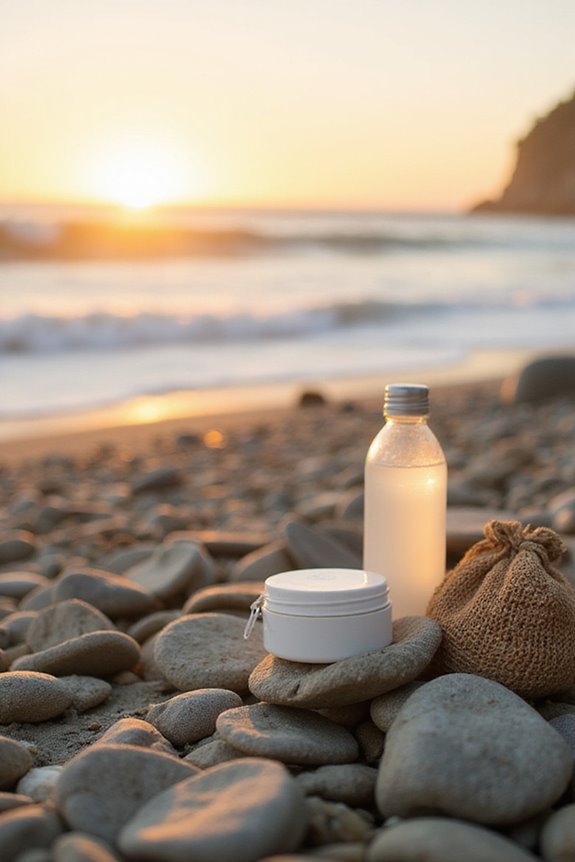
To enjoy our surfing experiences while protecting local ecosystems, addressing pollution in surf zones is essential. We need to identify pollution sources like sewage outfalls, industrial discharges, and urban runoff, which all greatly degrade water quality. These pollutants include bacteria, heavy metals, and microplastics, posing health risks for surfers and marine life alike.
To minimize pollution, we can take practical steps:
- Avoid surfing after heavy rainfall when runoff is likely.
- Use biodegradable sunscreens to reduce chemical contamination, such as reef-safe options that are less harmful to marine environments.
- Participate in beach cleanups to remove debris and microplastics.
Engaging in Local Conservation Efforts
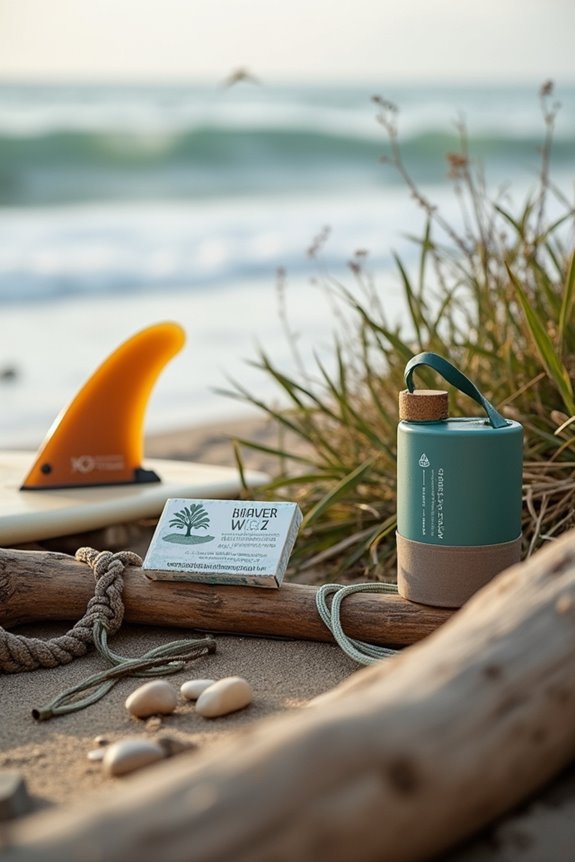
Engaging in local conservation efforts not only helps protect our oceans but also fosters a sense of community among surfers. By participating in community initiatives, we can contribute directly to the health of our surf breaks. Many surf communities lead grassroots efforts, such as weekly water quality tests or zero-waste restaurants, which inspire others to join the cause.
Through conservation partnerships, like those between surf organizations and environmental groups, we amplify our impact. For example, initiatives to establish Surf Protected Areas (SPAs) guarantee the protection of critical marine ecosystems. By uniting our passion for surfing with conservation goals, we can safeguard the coastlines we cherish and guarantee they thrive for generations to come.
Practicing Safe Surfing Around Wildlife
When we head out for a surf session, it’s crucial to prioritize our safety and the well-being of local wildlife. To minimize wildlife interactions, we should surf in groups, avoid dawn or dusk, and steer clear of murky waters. Opting for larger surfboards can also enhance surfboard safety by making us look less like prey to sharks.
Before entering the water, we need to observe the surroundings for signs of marine life. Avoid wearing shiny jewelry or brightly colored wetsuits, as these can attract predators. We must also minimize splashing, which can draw attention. Finally, being aware of local wildlife risks and following posted guidelines is key to ensuring a safe and respectful surfing experience. Additionally, understanding the local wildlife risks can help surfers make informed decisions while enjoying their time in the ocean.
Educating Yourself and Others
Being mindful of wildlife while surfing is just the beginning of our responsibility as surfers. We can enhance our surf education and wildlife awareness by engaging with community-driven programs that focus on marine biodiversity. These initiatives often provide valuable information about local ecosystems and conservation efforts.
We should also participate in citizen science programs, where we can learn while contributing to coastal ecosystem monitoring. Sharing our knowledge with fellow surfers, friends, and family helps spread awareness about the importance of protecting marine life.
Navigating Coastal Development Challenges
Steering coastal development challenges is essential for maintaining the balance between human activities and the natural environment. Coastal protection structures often alter wave quality, leading to surfing impacts that can diminish our experience. For instance, studies show that 18 out of 30 surfing sites experienced wave degradation after construction.
To mitigate these effects, we can engage with stakeholders early in the planning process. Strategies include:
- Artificial surfing reefs to enhance wave conditions
- Modification or relocation of coastal structures
- Beach nourishment to create wider beaches and habitats
Adapting to Climate Change Impacts
We can start by:
- Reducing our carbon footprint: Opt for sustainable transportation and support renewable energy sources.
- Participating in clean-up efforts: Help maintain clean beaches and waterways that protect marine habitats.
- Promoting conservation programs: Support local initiatives that focus on protecting vulnerable species like leatherback turtles and marine invertebrates.
- Staying informed: Educate ourselves about the impacts of climate change on marine ecosystems.
Building a Community of Conservation-minded Surfers
While many of us enjoy the thrill of catching waves, it’s important to recognize our role as stewards of the ocean. Building a community of conservation-minded surfers involves fostering connections through community partnerships and conservation initiatives.
We can participate in local education programs that highlight the importance of critical ecosystems, like mangroves and seagrasses. By engaging in beach cleanups and advocating against pollution, we promote sustainable practices that protect our surf spots.
Joining global organizations, such as Surfrider Foundation and Surfers Against Sewage, allows us to contribute to legal protections for surf breaks and surrounding habitats.
Through these collective efforts, we not only safeguard our surfing environment but also guarantee a thriving ocean for future generations.
Frequently Asked Questions
What Should I Do if I Encounter a Marine Animal While Surfing?
When we spot a curious dolphin, let’s remember it’s a dance of respect. We’ll stay calm, keep our distance, and follow safe surf practices, ensuring our marine animal interactions are peaceful and harmonious.
How Can I Identify Endangered Species in Surf Areas?
To identify endangered species, we should consult local conservation resources and overlay surf maps with protected areas. By prioritizing surf area conservation, we can enhance our awareness and protect vulnerable marine life while enjoying the waves.
Are There Specific Surf Spots Known for High Wildlife Activity?
There are wildlife hotspots around the globe that make surfing feel like riding on the back of nature itself. By practicing proper surfing etiquette, we can enjoy these vibrant ecosystems while ensuring their preservation for future generations.
Can Surfing Impact Local Fish Populations or Habitats?
Yes, surfing can impact fish population dynamics and cause habitat disruption. As we ride the waves, our presence can disturb sensitive breeding grounds, potentially affecting local fish populations and the overall health of marine ecosystems.
What Role Do Local Communities Play in Wildlife Protection?
Isn’t it incredible how local communities drive wildlife protection? Through community engagement and conservation initiatives, we unite to safeguard ecosystems, ensuring that our coastal treasures thrive for generations, balancing our love for surfing with responsibility.

